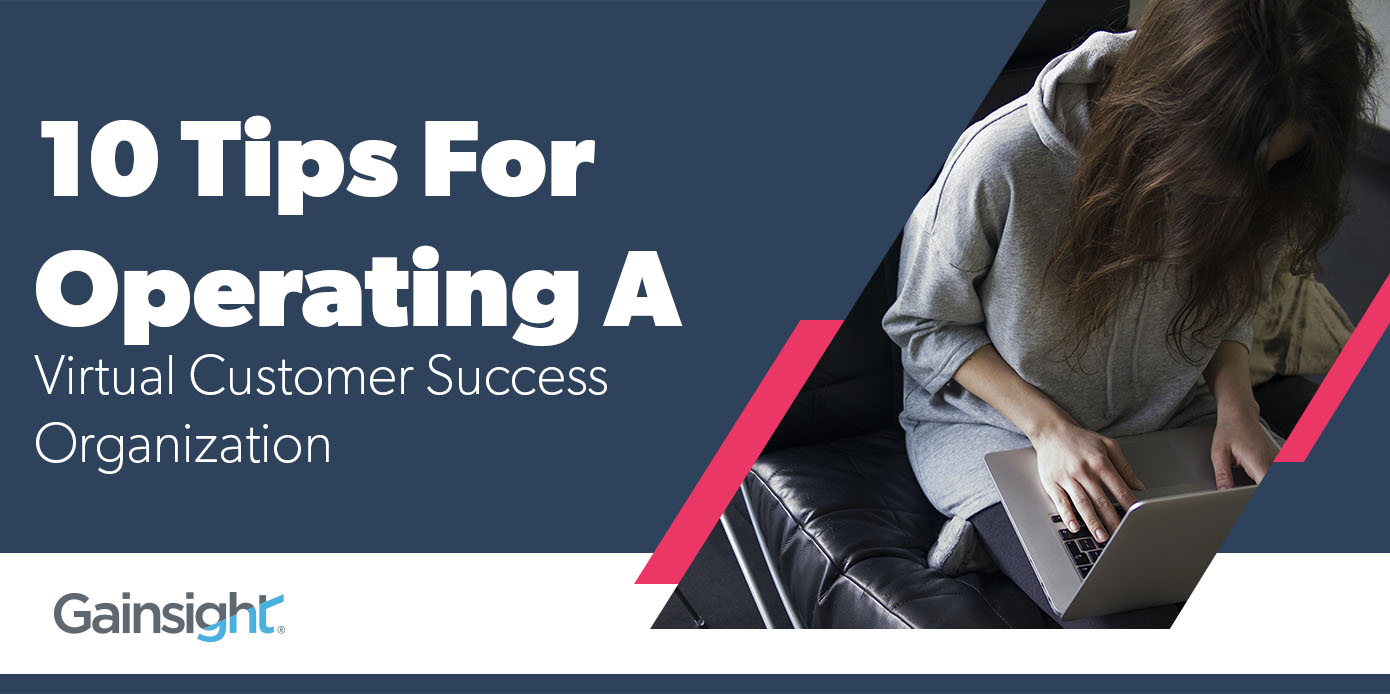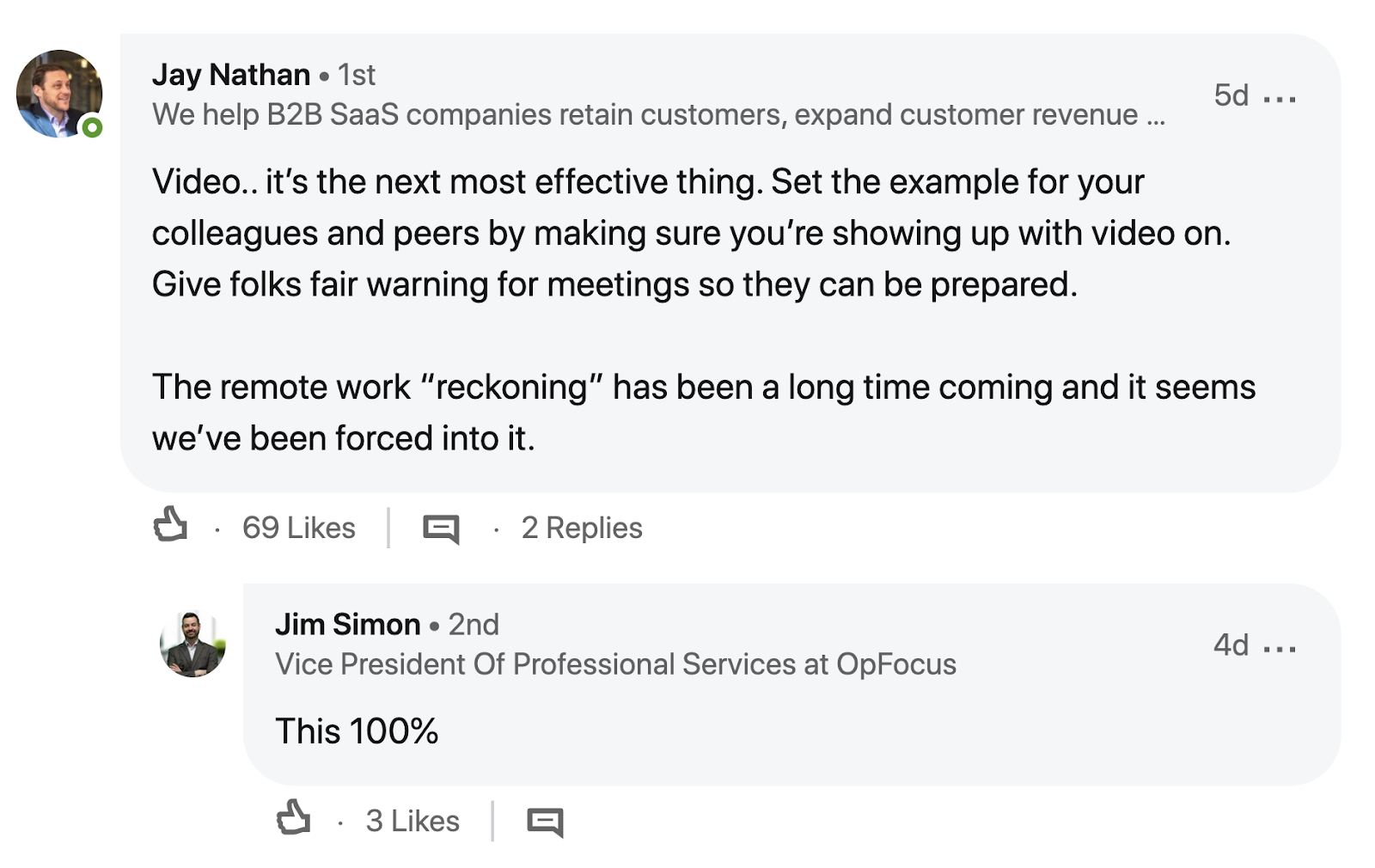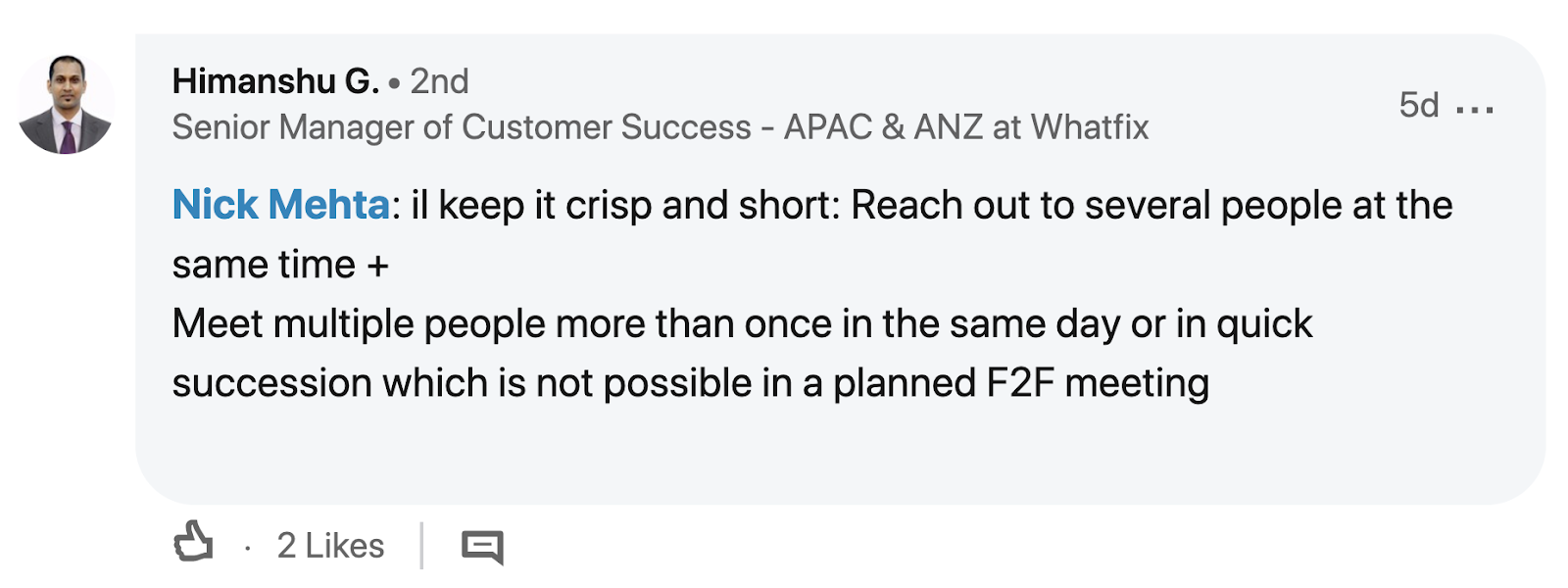Do you remember New Year’s Eve? I do.
I’m talking about New Year’s Eve—this year. 2020. The start of a new decade. The twenties. At least now we just say “the twenties”. The “aughts” and the “teens” didn’t exactly roll off the tongue. When you look back at January 1, 2020—the hopes, the dreams, the resolutions—it all feels so long ago.
But I’m pretty sure no one outside of perhaps China was thinking “global quarantine” by mid-March.
But here we are. The current situation has foisted millions of people into their first experience working from home. And that’s driven thousands of customer success professionals who were used to seeing their clients and teams every day to learn the ins and outs of “virtual” CS.
I know this is a hot topic because I asked for best practices on LinkedIn from the #CustomerSuccess community and within a few hours, I had received more than 100 comments with ideas:
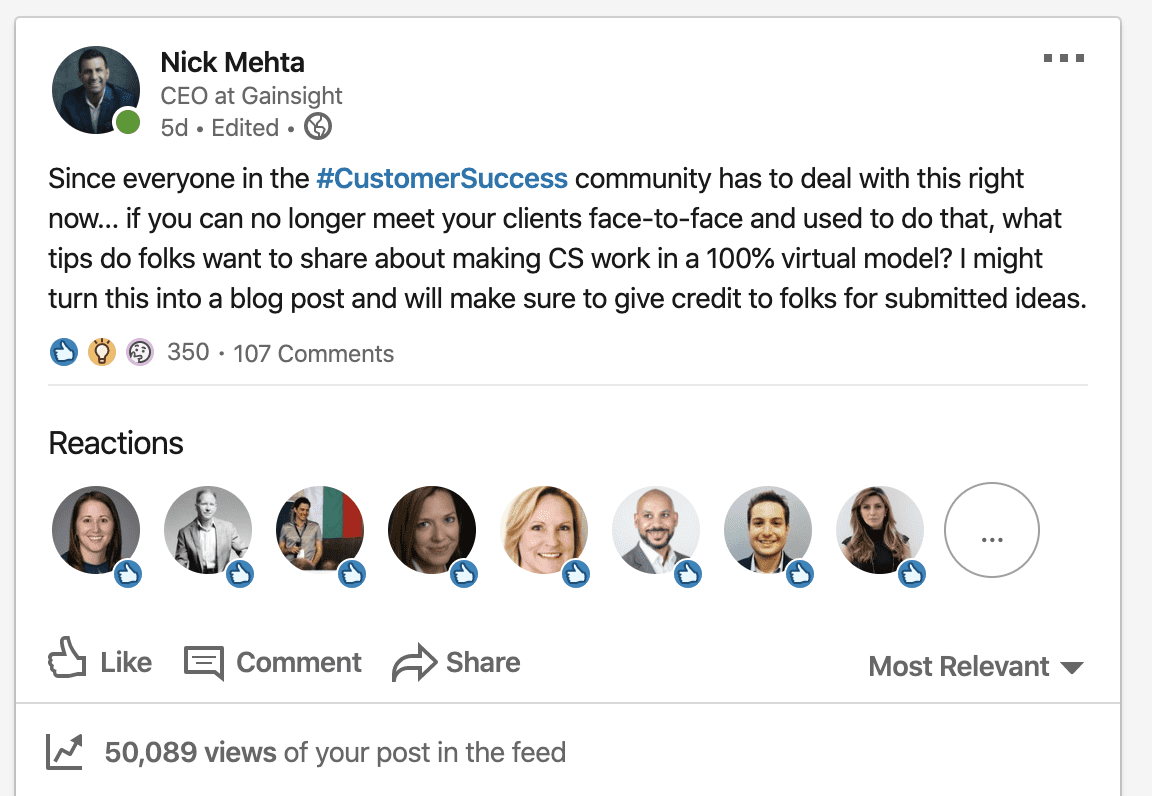
In addition, we polled our teammates (whom we affectionately call “Gainsters”) for their ideas. I’ll now share with you five ideas that are “common sense, but uncommonly practiced” and five ideas that maybe push the envelope a bit.
We hosted a webinar with Slack on this topic. Watch the recording here!
5 Common Sense, Uncommonly Practiced Ideas
1. Turn On Video
Thanks to many, including Marco Innocenti and the team at Zoom, as well as Jay Nathan.
We all know this one and we all know we should do it. And we often have reasons why not to: wardrobe, lighting, background or, dare I say it, not wanting to get caught multi-tasking. But we also know that once one or a few people turn on video, everyone does it. Several commenters in the LinkedIn thread noted studies of increased Sales and CS performance with video on versus not.
I’ll share a personal anecdote on that account. Early in Gainsight’s tenure (2014), we had a big client (still a customer today) who had a feature request and wanted to see our roadmap. We presented via audio and slides on a web meeting. The client exec called me afterward and said, “It feels like you just aren’t listening to us.”
Fast forward another week and we presented again, this time with video on. After the call, the exec said “I’m so pleased with how client-centric you are being. You really understand us.” The funny thing is that we ran out of time during that preceding week to change our roadmap much at all. So the client was mainly responding to seeing us. Video works.
2. Send an agenda beforehand and notes afterward
Kevin Leonor and Deepak Karandikar
This is business 101, right? Why do I need to read a blog post about this?
The answer is it’s because I’m in so many meetings with vendors where this doesn’t happen. And indeed, we have to train our teams and coach them to make sure this happens at Gainsight.
The agenda serves a dual purpose:
- Get the client to confirm the content is what they want.
- Remind the client to show up.
Pro-level CSMs will even socialize the agenda beforehand with a “champion” at the customer as well. Even if the client doesn’t respond to the agenda, at least you can say that you sent it.
And sending notes afterward is another no-brainer that don’t always—or even often—happen. Notes demonstrate the diligence that your team is taking and they make sure accountability is clear on both sides.
3. Raise your bar on volume in the virtual model
If you’re used to mostly face-to-face meetings, you may be happy with even just one client meeting per day. Experts in the virtual model might meet six clients per day. The lack of planes, trains, automobiles, and lobby sign-ins gives you back hours every day and week. Use that time to go deeper with your clients. Instead of just meeting your champion and executive sponsor, meet more of your users. Meet your IT counterparts. Even say hi (virtually) to the procurement person!
To do all of this, consider finding ways to connect with your clients digitally, in a “tech touch” model, and then use that outreach to drive virtual meetings.
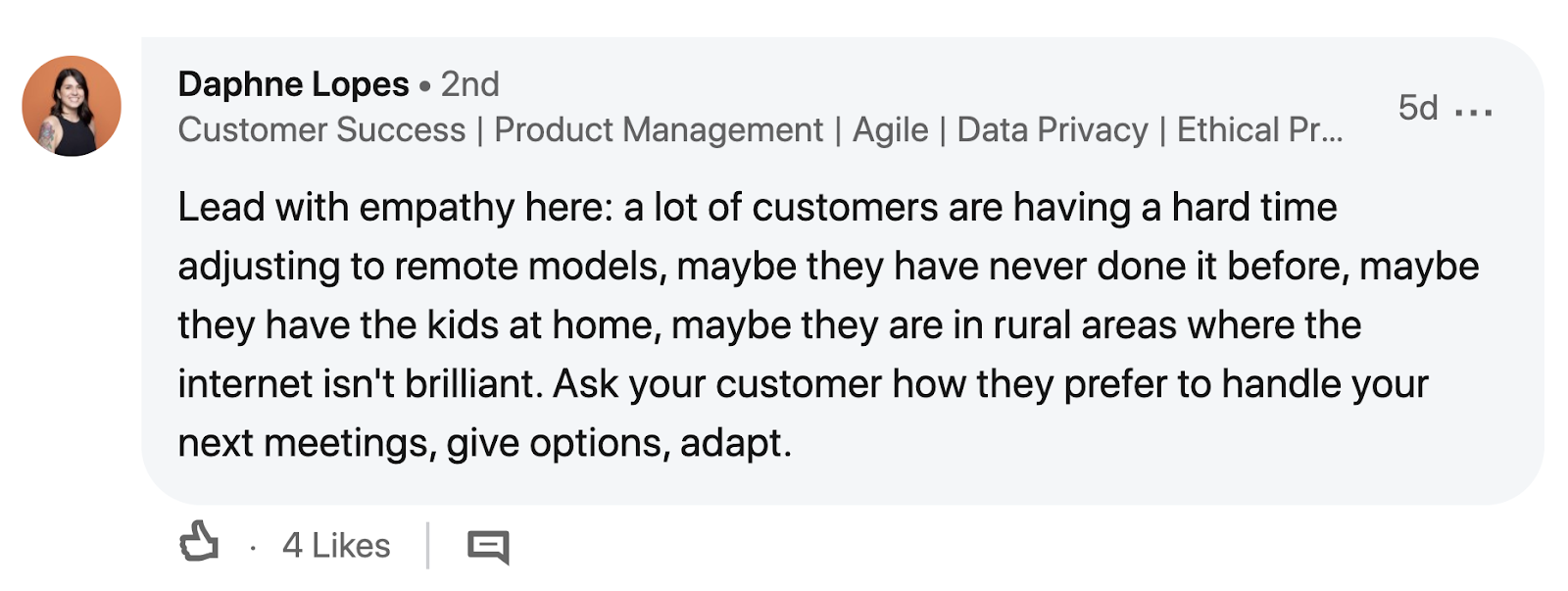
4. Lead With empathy
Particularly in this time, make sure you start your call with compassion. Ask them how they are doing with the global situation, and if you can help. Then (crucially) follow through.
Do they want to use a different video technology than the one you prefer? Fine.
Proactively tell them that if they are working from home, you understand that there may be noises (kids, pets, fellow “work-from-homers”) in the background—and open up that the same might happen for you.
And if you want to really delight them, finish the call five minutes early!
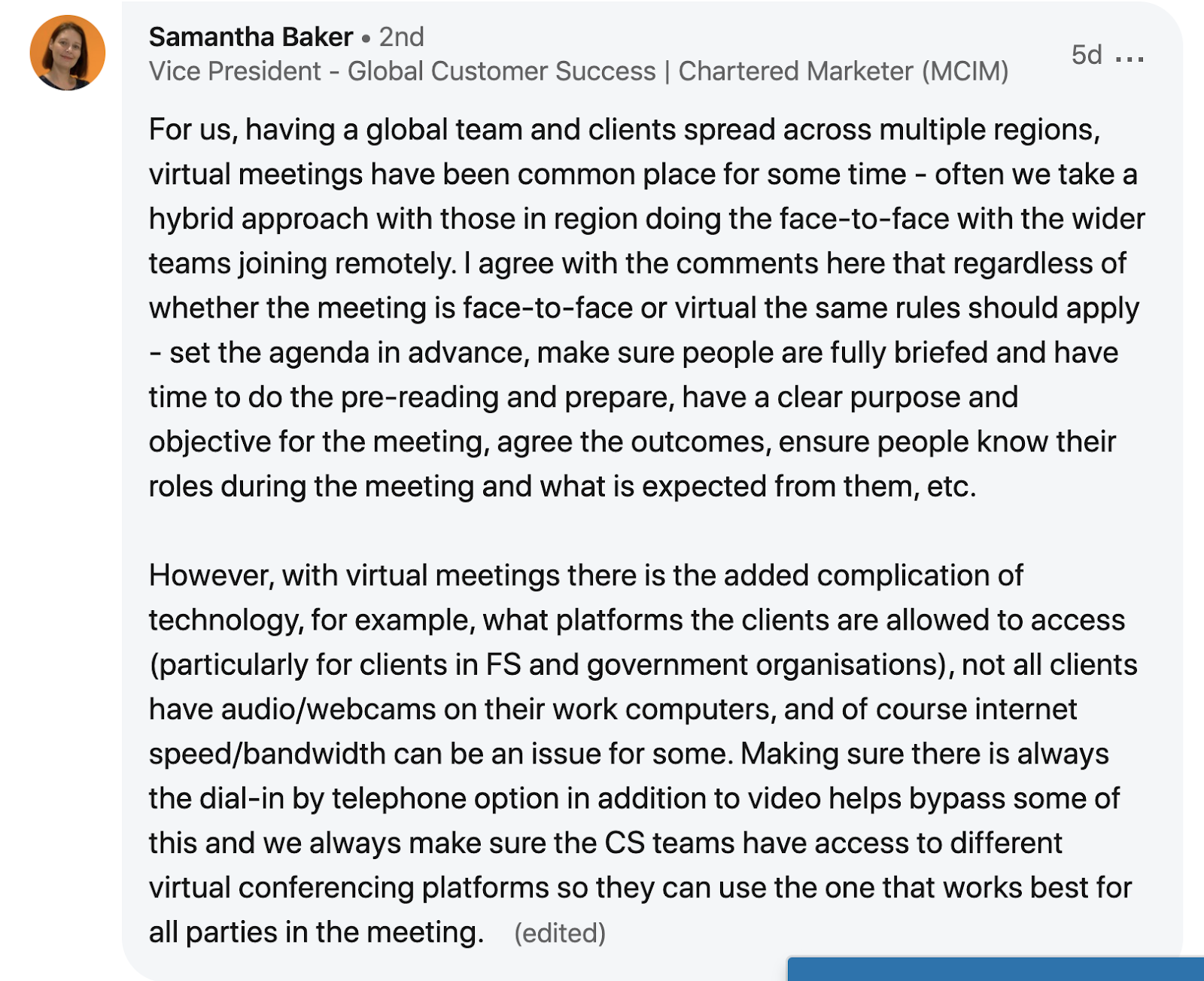
5. Get your team on the same page about customers
In a model where everyone is virtual, there is no hallway conversation and no watercooler talk. So you’d better have it written down. Health scores should be well-defined. Notes should be in one place. The client’s goals and success plans should be easily accessible. And everyone should know who owns what in terms of next steps at all times.
I like to call this “industrialization” of customer success. One person—no matter how brilliant—only scales so much. Other functions have this down. It’s time for CS to adopt industry-wide best practices as standard.
5 Non-Obvious Ideas
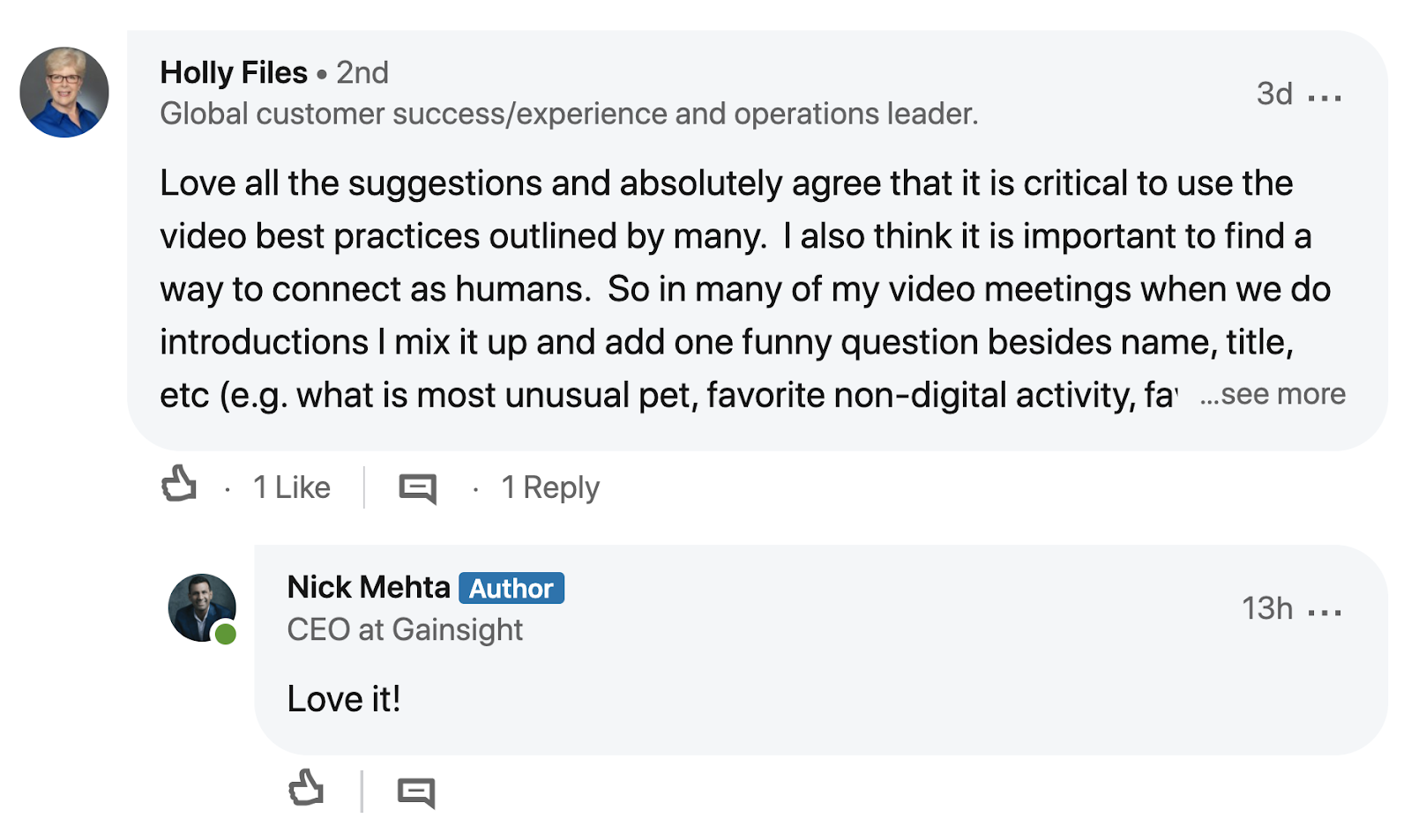
1. Start your meetings with childlike joy via icebreakers
Holly Files and Willow Moellering
Childlike Joy is a Gainsight Value and shows up a lot on the internet.
But you don’t need a fancy film crew to bring smiles to your clients. As a part of the ever-so-riveting call intros, try asking a fun personal question. Maybe not too personal, but something like:
- What’s your go-to karaoke song?
- What was your childhood dream?
- What would be your career in an alternate life?
- What positives are coming from work-from-home, if that’s new for you?
Srivaradha Vanamamalai even suggested taking your client on a virtual tour at the beginning of your call of your home or office. Anything to get them talking and opening up.

2. Use modern online meeting tips
Amanda Neil is a fan of using the whiteboard feature in video meetings to make the meeting feel less “canned.”
One of our teammates internally suggested having everyone be “off mute” (shudder at the thought!) so the meeting feels more like an in-person one.
Jessica Weisbrot suggested sending food via UberEats to add an in-person touch to the virtual setting.
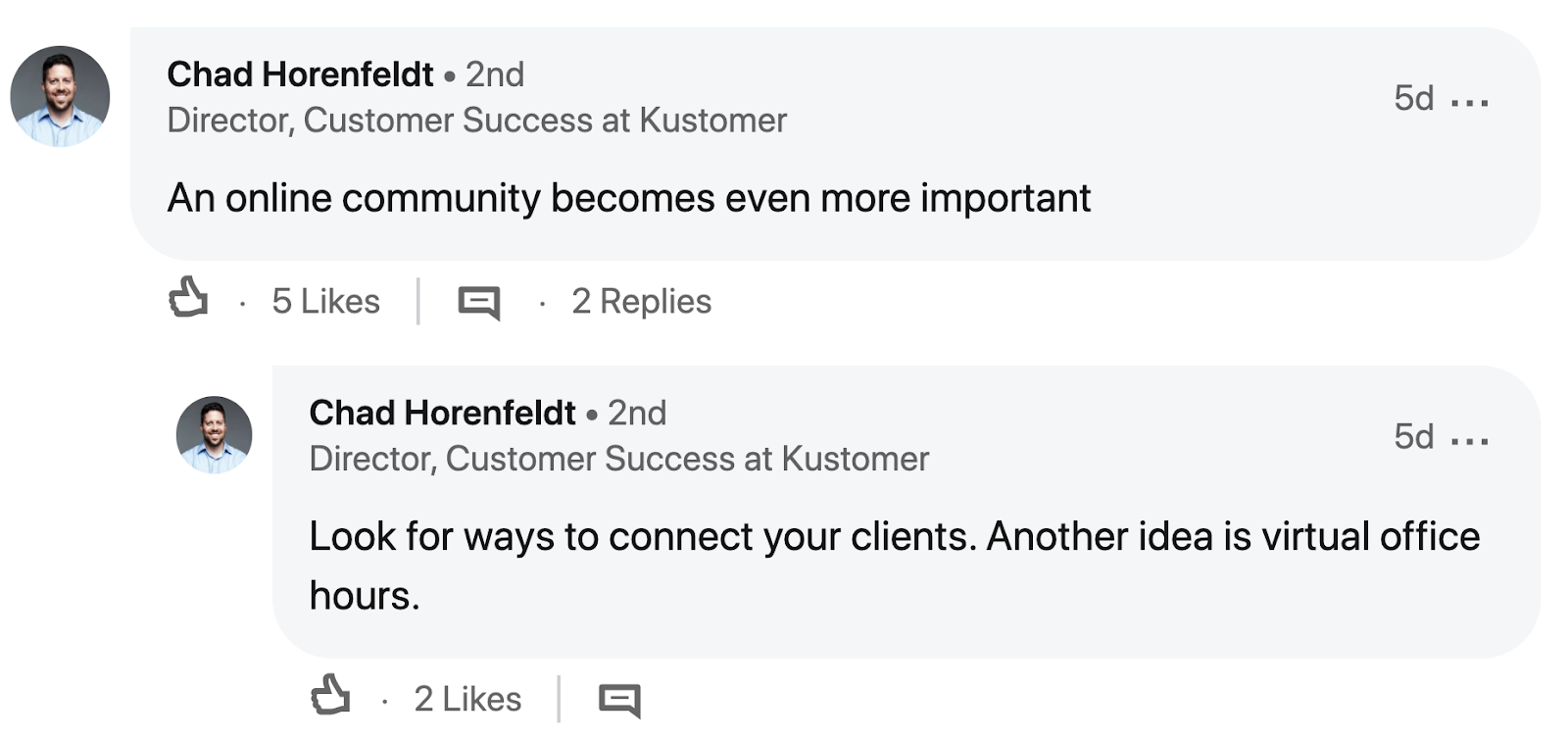
3. Use community to bring people together
Chad Horenfeldt suggested this point and it resonated with me. Online communities become more vibrant when there’s less chance for in-person interaction. In addition, they drive that magical “customer-to-customer” connection.
And our friend Spencer Graham at Slack made a plug for using the “shared channels” feature.
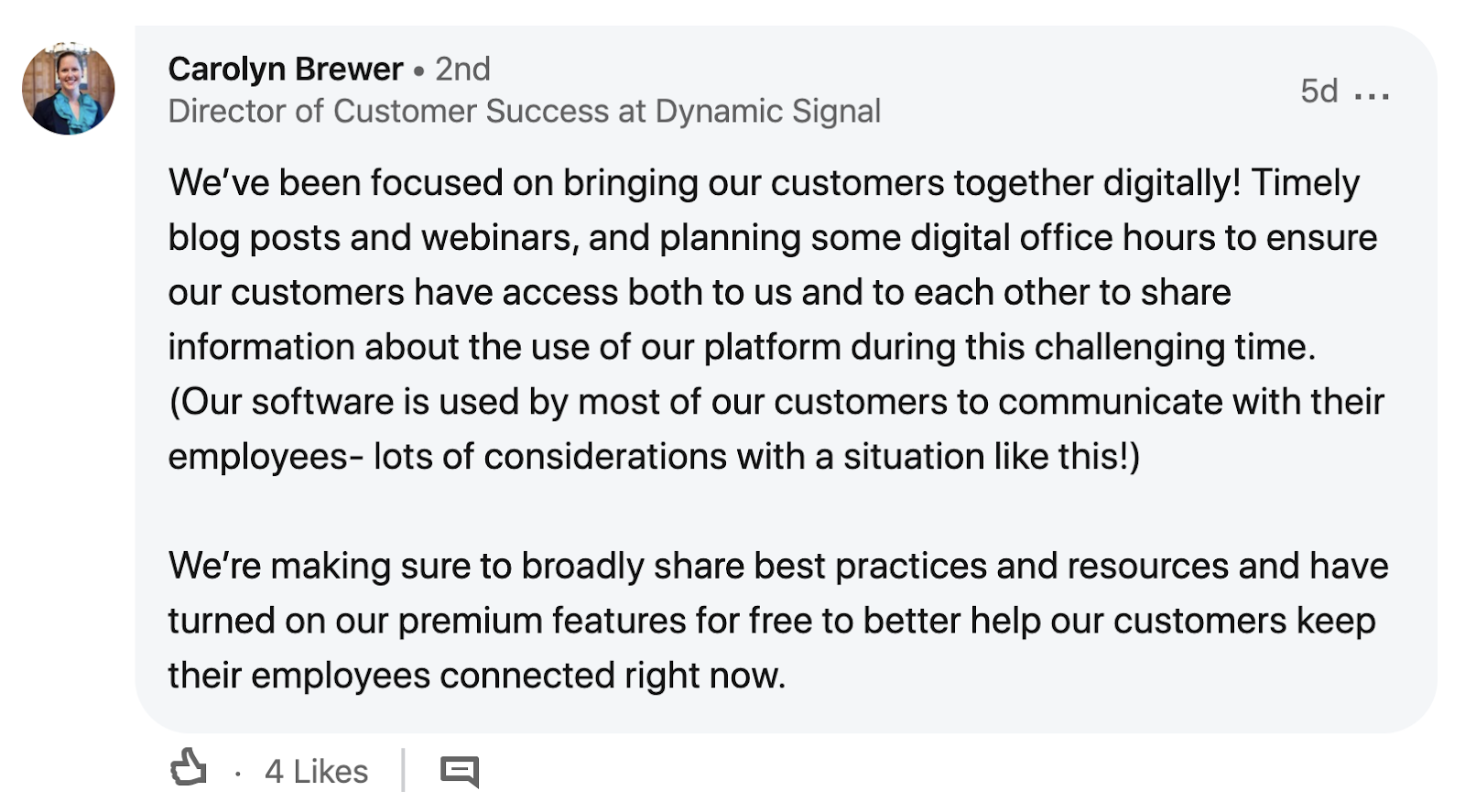
4. Use your product to be there all the time for the customer
The best CS teams have extended customer success into the product via in-app messaging, walkthroughs, guides, surveys, and the like. They are able to continue the customer journey from the sales process to the onboarding to the EBRs to the actual product experience. And the in-product interaction becomes a rich source of data and feedback for future personalization.
There are a ton of ways to do this—we’re obviously partial to Gainsight PX. However, especially during times like these, it’s critical to get the message right and the timing right as well. At Gainsight, every message we send in-app must pass our TRUSt Framework. I encourage you to develop your own criteria as well.
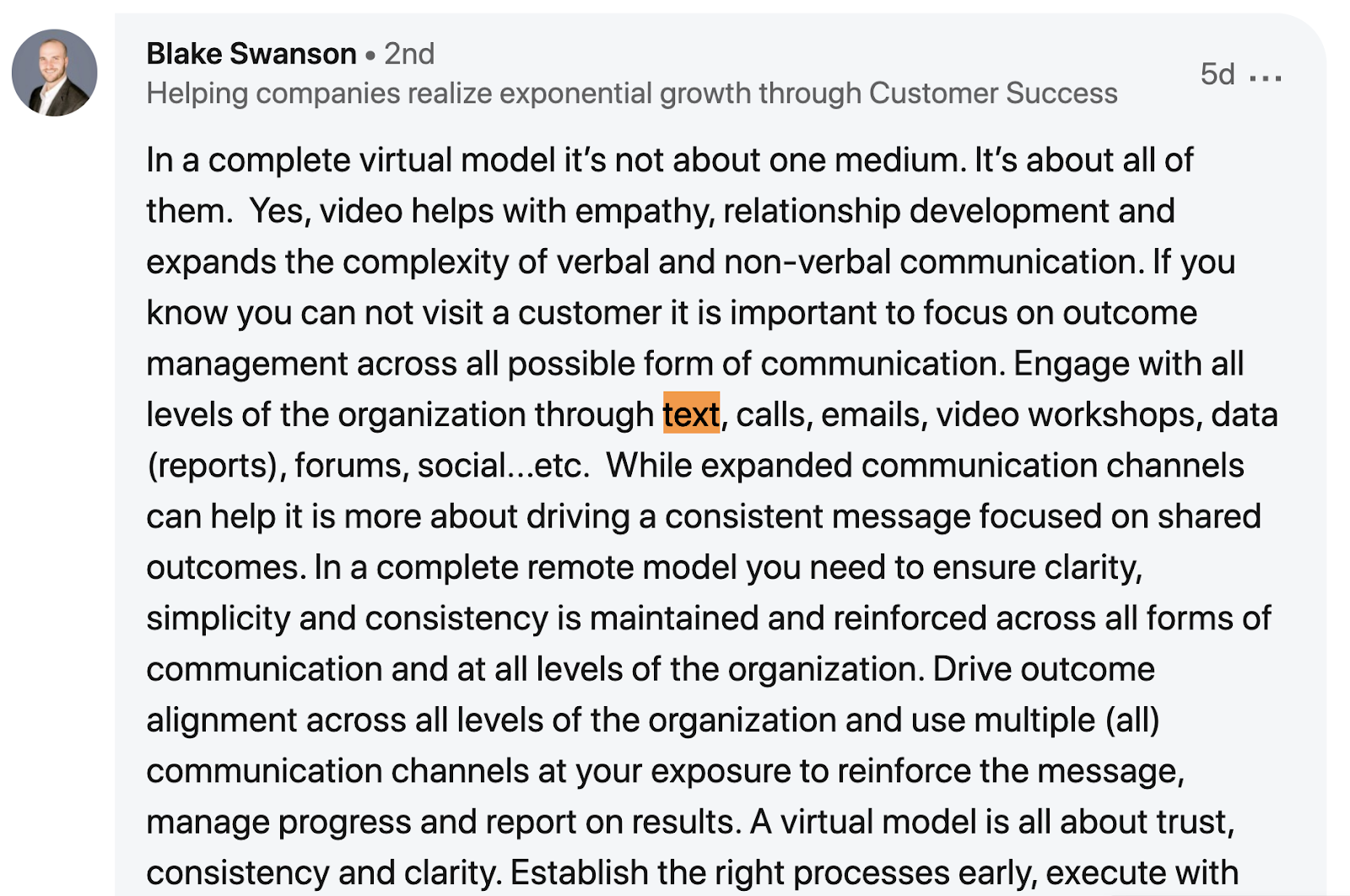
5. Text your clients
Finally, I’ve found that the true sign of a deep client relationship is being able to text with them. This isn’t always true (some aren’t comfortable), but I’ve found that people open up so much more when they are off easily-forwardable email. Again, as with any messaging, sticking to your values (for us, the Golden Rule) is paramount.
Conclusion
Life—and business—must go on despite this ongoing hardship. We’re all under pressure in our own personal lives, in our internal business organizations, with our external customers—and they’re under those same pressures. Some industries may be deeply hurting, while others could be struggling to keep up with sudden demand.
As you extend empathy to your customers, I encourage you to extend it to your self as well!
We hosted a webinar with Slack on this topic. Watch the recording here!
